A Chapter 16 (and 7-Imp) Visit with David Wiesner
 September 17th, 2020 by jules
September 17th, 2020 by jules
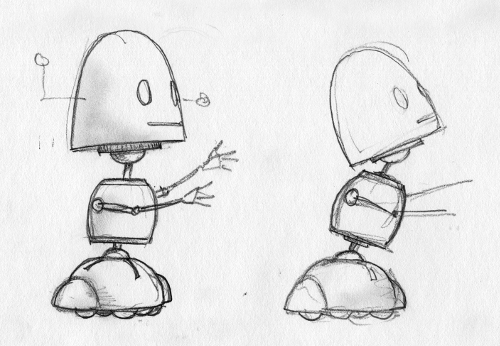
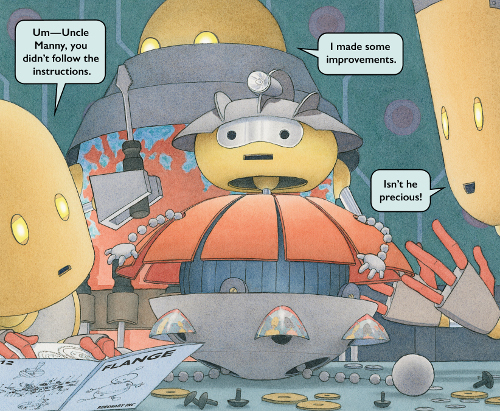
(Click image to see spread in its entirety)
Over at Chapter 16, I have a Q&A with author-illustrator David Wiesner. He and I chatted via phone recently about his career; his newest picture book, Robobaby; and more. That Q&A is here.
But also! Here at 7-Imp, David gives us a deep dive into the making of Robobaby. That is below, should you be interested in that after reading the Chapter 16 piece.
I thank him for sharing.
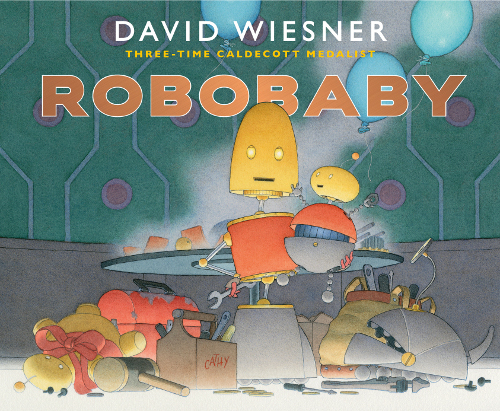
David: Robobaby grew out of the work I did on my app, David Wiesner’s Spot. (It’s only available on an iPad and now only 99 cents! Search for it with that full title; otherwise, you’ll get Eric Hill’s Spot apps.)
One of the worlds in the app is a robot world. I designed a lot of characters and environments.

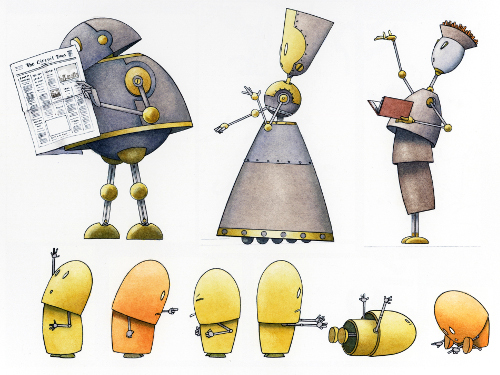
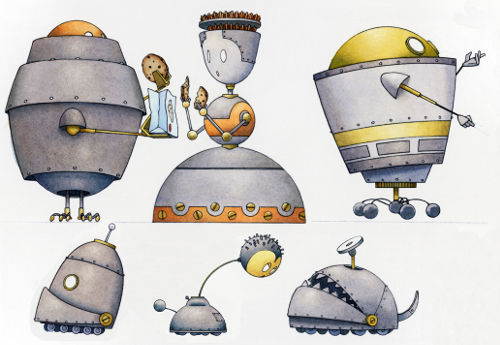
I had wanted to go inside the houses to see the families, but that ended up not being feasible (long story). Here is a sketch of a family group:
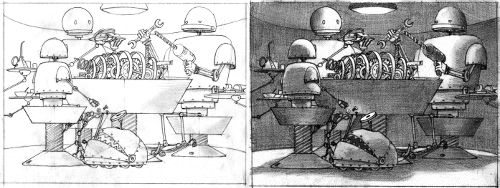
I consoled myself by realizing that I could make a book about them.
When I started to think about a “robot book,” I first drew spare parts, then a big box of parts. Of course, those parts would have to be assembled—but into what? Aha! This must be where robot babies come from! They are ordered from Robobaby, Inc.
That led me to think about how adults always seem to need kids to show them how to use current technology, even when they seem to think they know what they are doing. Everyone has an opinion, often wrong.
Initially, the family—mom, dad, and daughter—were more onlookers to the mayhem caused by the relatives and friends. It became clear to me that the daughter, Cathode—aka Cathy—was the main character. She truly knows what to do and is frustrated, because she just wants to play with her new baby brother.
In addition to Cathy, I had many different robot designs and wanted that big cast of characters. I still wanted the mayhem. I saw a world ripe for slapstick, using as a muse of sorts the great “stateroom scene” from the Marx Brothers’ A Night at the Opera, which you can find (possibly with the help of your kids) on YouTube.

The Marx Brothers are in their tiny stateroom:

More and more people come and enter the room:

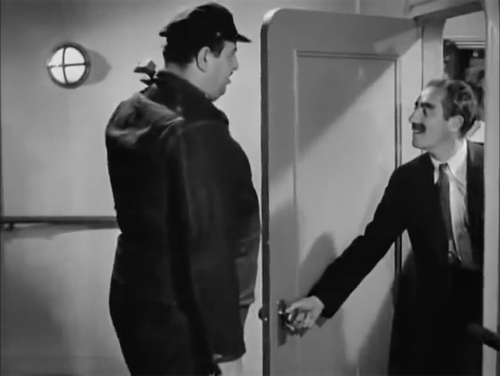

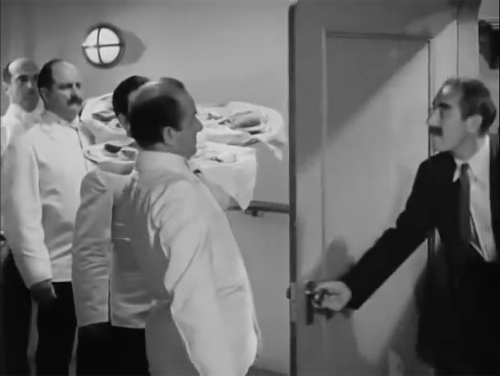
Until the room is packed to the ceiling:

And then the great final moment when poor Margaret Dumont opens the door:
Late in the book, I created a version of that last bit:
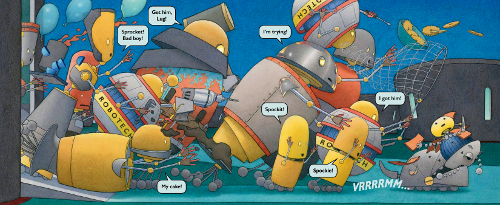
I write with pictures. If there is text, it becomes part of the process, changing as dictated by the images. I begin with thumbnails in my sketchbook …
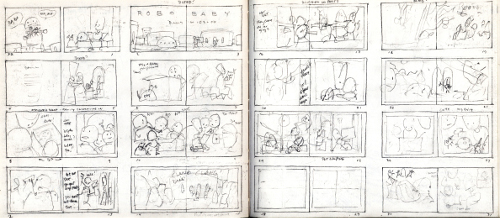
… and then move to a larger, full-size pencil dummy. I don’t care what the drawings look like in the dummy. I don’t spend a lot of time on them. This is about writing and story. The actual design of the characters and the world come after. So, early images are, as I said, rough.
Initially, I tried having the text outside the images:

Then I had text both outside the images and word balloons inside the images:
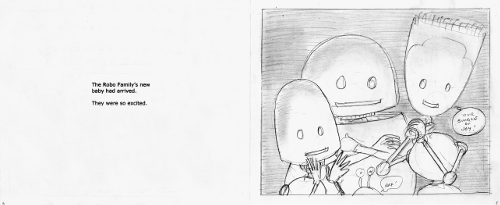
I ended up having all the text as dialogue contained in word balloons:
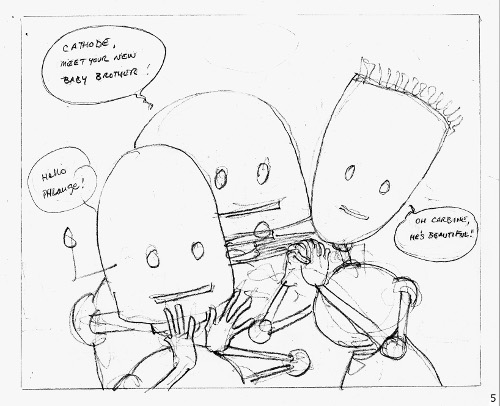
When the story is basically finished (things will always continue to change), I move on to creating the characters and building the world.
I had designed the characters for the app, but the were only seen once. For the book, they had to be far more expressive. Their faces had to show emotion, as did their body language.
I drew them in different positions. I thought about how collapsible drinking cups could fold up and also bend in the segments a bit. This would allow them to bend, kneel, lie down.
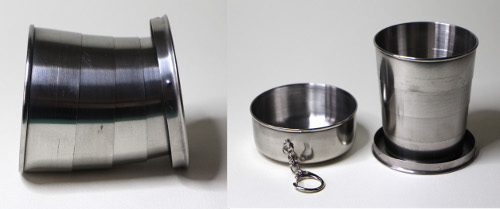

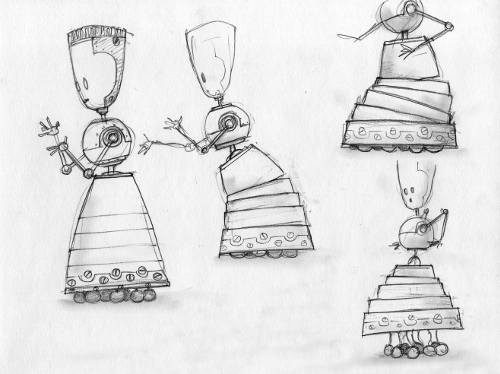
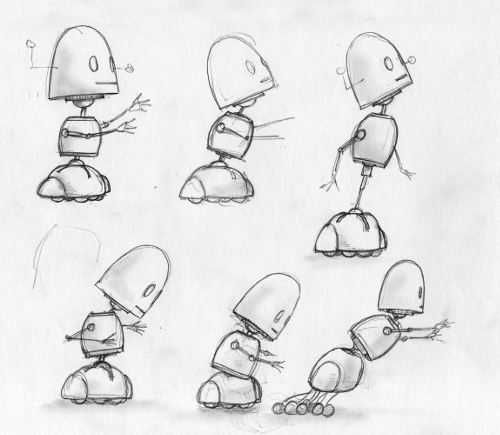
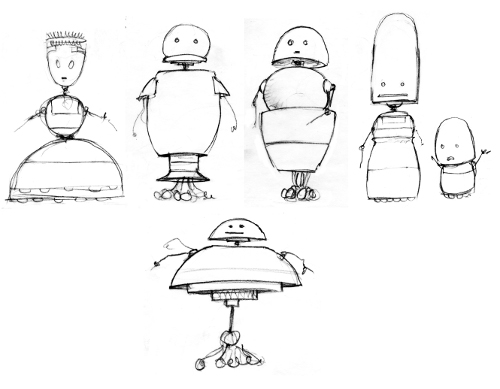
I didn’t give any of them legs. It took them one more step (ahem) away from human. They all roll around on casters—kind of like Rosey from The Jetsons:
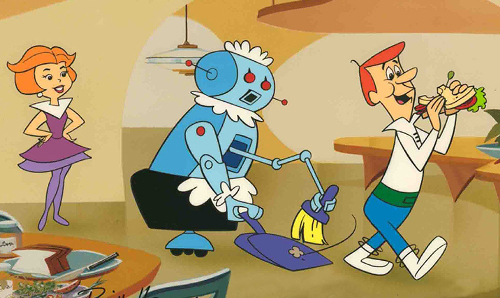
I always make models of the characters in my books. I want to see them from all angles and under different lighting situations. You can now do this on the computer, but I like to make them so that I can hold them and have them on my desk as I work.
As an example, here’s Arthur from Art & Max:

I use Crayola Model Magic. It’s lightweight and dries quickly. It’s a very simple model— enough for me to see the basic form that I can turn in space.
This is how he looks in the final art:
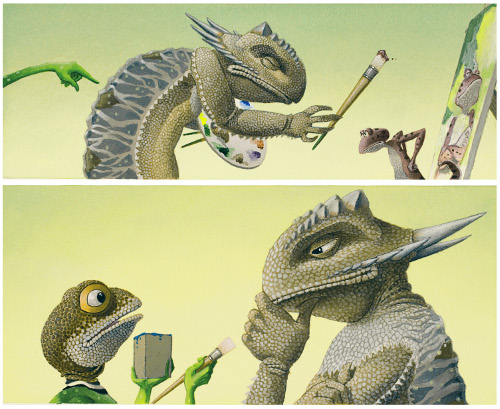
When I was ready to make robot models, I realized I could create them differently, particularly since they are all symmetrical. I did technical specs with measurements, and my son created CAD files for them. I sent those to a company, and a week or so later I had 3D-printed plastic models:

The nuances of the faces and bodies evolve. Here are a couple heads, showing Cathy’s development:
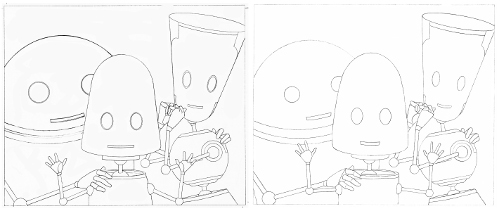
These are the drawings I use as the basis for my final paintings. I will do all the pages before I begin to paint. I print the drawings and make a dummy that can be read and whose pages can be turned. You have to—well, I have to—see it and experience it in its final form. Looking at it on a screen is not the same experience.
After I have the drawings done, I go through and mock up where I want the word balloons. This is the guide for the designer (Carol Goldenberg Rosen, who I have worked with on all of my authored books).
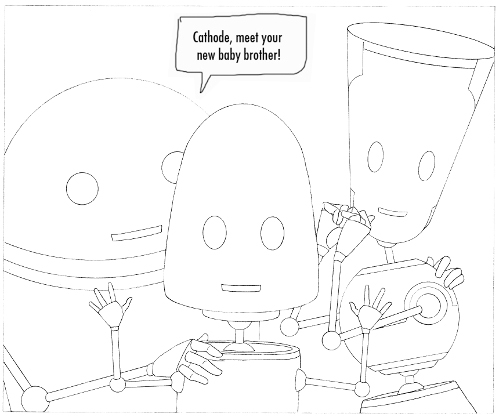
The paintings are done in watercolor. Here is the above page in its final form and with text in place:

Another example with text mock-up:
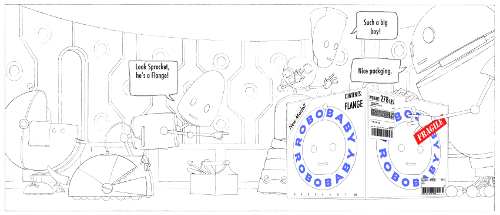
And final art:
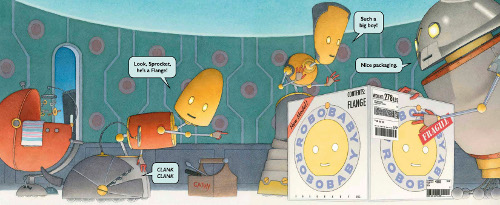
You may have noticed (I hope you did) that the light source in the robot house is in the floor. I have been waiting many years to have a room with the light source in the floor. This stems from the profound impact of seeing the film 2001: A Space Odyssey in a theater at the age of 11. (See also this visual essay at my site.)
Late in the film (no way to summarize it here!), we are in a strange hotel room:

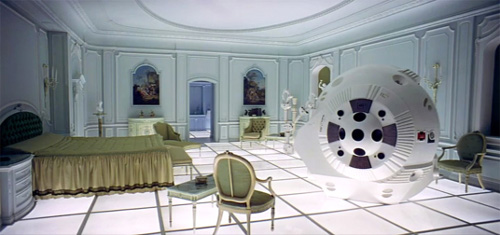
The floor is the light source! It’s beautiful. I have been waiting decades to use that somewhere, and Robobaby was the perfect place:
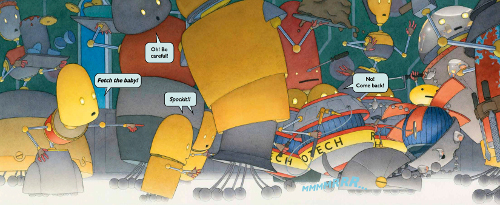
I was able to put my models on my light table to get the feel:

The baby’s crib was fun to design. I love the big round shape. As I was sketching possibilities, I realized: Weber grill!

When designing the robot neighborhood, I was looking at various kinds of circuit boards and made another connection with my days growing up in New Jersey:

These gas storage tanks off the Jersey Turnpike have a wonderful geometric quality, especially at that size and sitting out in that landscape. They became one of the influences on the robot world design:
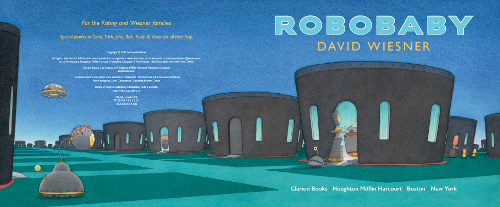
(Click to enlarge)
As I’m creating the look of characters and environments, I draw from many, many places. Things that are the most personal to me make the things I create more unique and, I hope, interesting to the reader—whether they recognize where the influence came from or not.
The last thing I’ll mention is the case. (That’s what the cover is called. The jacket is the thing that goes over the case.) If you take the jacket off Robobaby, you will see this:

That is the packaging for the Robobaby, Inc. box that little baby Flange comes in. So, the book is also a box, the one that contains the story. (Take a close look at the shipping label. Depending on your sense of humor, you may find it amusing).
Here are some more final illustrations from the book:

(Click to enlarge)

(Click to enlarge)

(Click to enlarge)

(Click to enlarge)

(Click to enlarge)
ROBOBABY. Copyright © 2020 by David Wiesner. Illustrations reproduced by permission of the publisher, Clarion Books, Boston. All other images reproduced by permission of David Wiesner.

This was an amazingly inspiring read. Thank you for illuminating this process! Can’t wait to get my clamps on this book 🙂
Always inspiring to get the background to David Wiesner’s process and work. My copy arrived today and it’s just brilliant. Thank you for sharing.
Plus, I had to smile because in order to leave a comment here, I had to prove that I am not a robot! 🙂
Adrienne: Ha. Perfect! I meant to do that. (Er, not really. I had to resort to that because of a bad spam problem years ago.)
Back in my days as a children’s librarian I used to be sure to read every new book by Wiesner ot my kids as soon as i was released. One of the few fan letters I’ve ever written was to him, thanking him for his work and telling him how much joy his books had brought to me and my students. He wrote back (!) and that cemented my fanboy status.
Seeing his thought process was fascinating! Using the Stateroom scene from “A Night at the Opera” and the floor lighting from the ending scenes of “2001” show an appreciation of influences that I love.
Reading this made my day, Jules. Thanks!